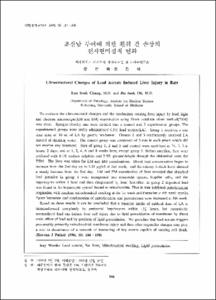초산납 투여에 의한 흰쥐 간 손상의 전자현미경적 변화
- Affiliated Author(s)
- 장은숙
- Alternative Author(s)
- Chang, Eun Sook
- Journal Title
- 대한병리학회지
- ISSN
- 0379-1149
- Issued Date
- 1996
- Abstract
- To evaluate the ultrastructural changes and the mechanism causing liver injury by lead, light and electron microscopic(LM and EM) examination using Timm sulphide silver method(TSM) was done. Sprague-Dawley rats were divided into a control and 3 experimental groups. The experimental groups were orally administered 0.5% lead acetate(LA). Group 1 received a one time dose of 10 ml of LA by gastric intubation. Groups 2 and 3 continuously received LA instead of drinking water. The control group was composed of 3 rats in each group which did not receive any treatment. Rats of group 1, 2 and 3 and control were sacrificed at 1/2, 1, 1 1/2 hours, 2 days, and at 1, 2, 4, 6 and 8 weeks later, except group 3. Before sacrifice, they were perfused with 0.1% sodium sulphide and 2.5% glutaraldehyde through the abdominal aorta for TSM. The liver was taken for LM and EM examinations. Blood lead concentration began to increase from the 2nd day up to 3.29 microgram/ml at 2nd week, and the urinary delta-ALA level showed a steady increase from the 2nd day. LM and EM examination of liver revealed that absorbed lead granules in group 1 were transported into sinusoidal spaces, Kupffer cells, and the hepatocytes within 1 hour and then disappeared 1/2 hour thereafter. In group 2 deposited lead was found in the hepatocytic cytosol bound to mitochondria. That in turn inhibited mitochondrial respiration with resultant mitochondrial swelling at the 1st week and thereafter at 6th week myelin figure formation and condensation of mitochondria, and peroxisomes were increased at 8th week. Based on these results it can be concluded that a transient intake of subletal dose of LA is biotransformed completely by periportal hepatocytes within 1 1/2 hours, but excessively accumulated lead can induce liver cell injury due to lipid peroxidation of membrane by direct toxic effect of lead and by products of lipid peroxidation. We postulate that lead acetate triggers presumably primarily mitochondrial membrane injury and then other organellar changes may play a role in disturbance of a network of interacting of key events capable of causing cell death.
Key Words: Lead acetate; Rat liver; Mitochondrial swelling; Lipid peroxidation
- Alternative Title
- Ultrastructural Changes of Lead Acetate Induced Liver Injury in Rats.
- Publisher
- School of Medicine
- Citation
- 장은숙 and 오진석. (1996). 초산납 투여에 의한 흰쥐 간 손상의 전자현미경적 변화. 대한병리학회지, 30(3), 184–198.
- Type
- Article
- ISSN
- 0379-1149
- Appears in Collections:
- 1. School of Medicine (의과대학) > Dept. of Pathology (병리학)
3. Research Institutues (연구소) > Institute for Medical Science (의과학연구소)
- 파일 목록
-
-
Download
 oak-bbb-1167.pdf
기타 데이터 / 27.03 MB / Adobe PDF
oak-bbb-1167.pdf
기타 데이터 / 27.03 MB / Adobe PDF
-
Items in Repository are protected by copyright, with all rights reserved, unless otherwise indicated.